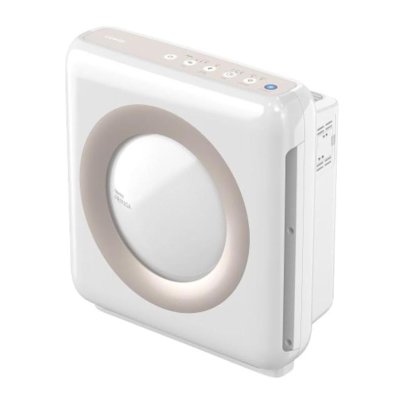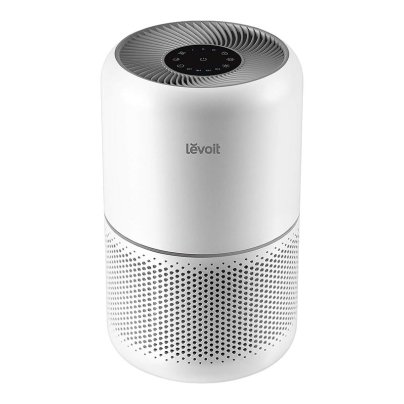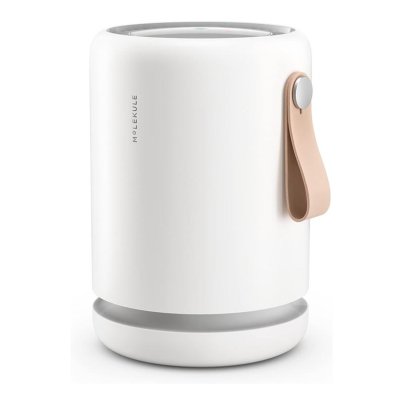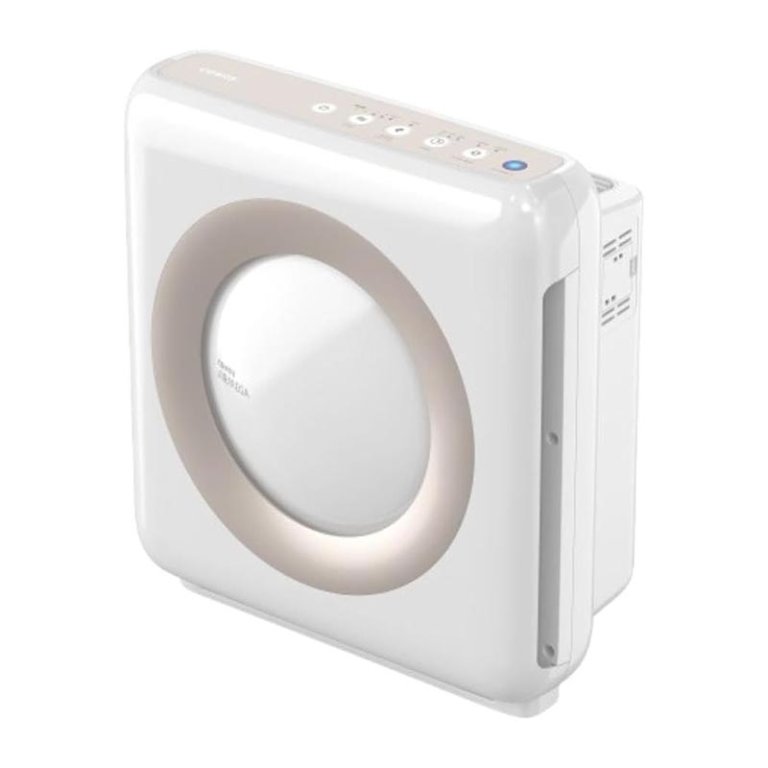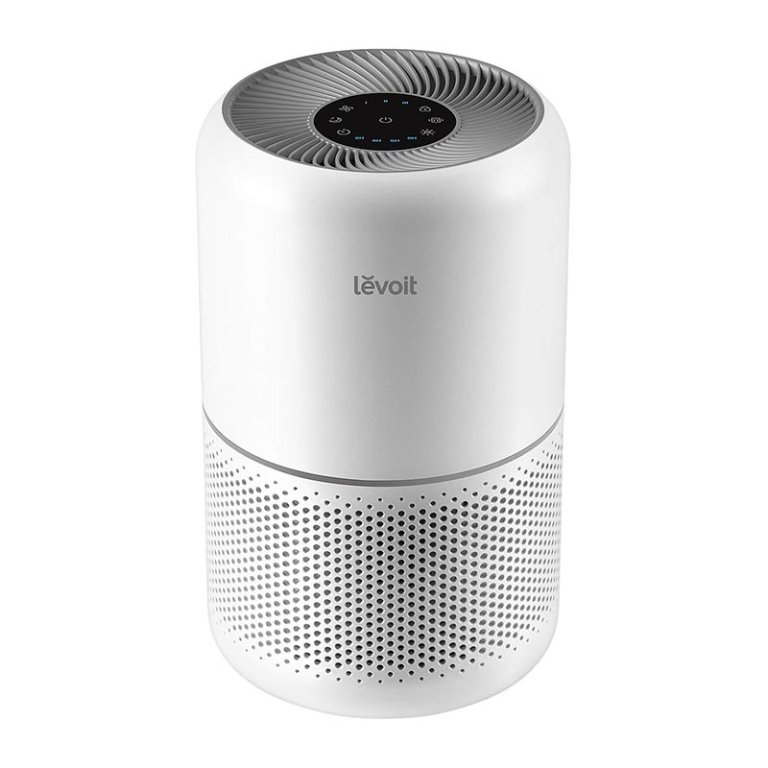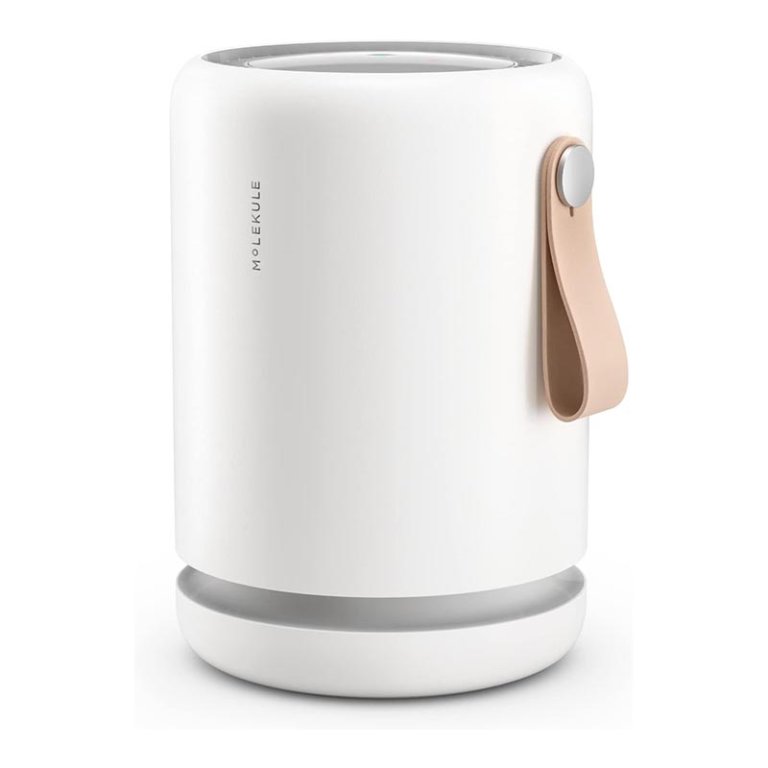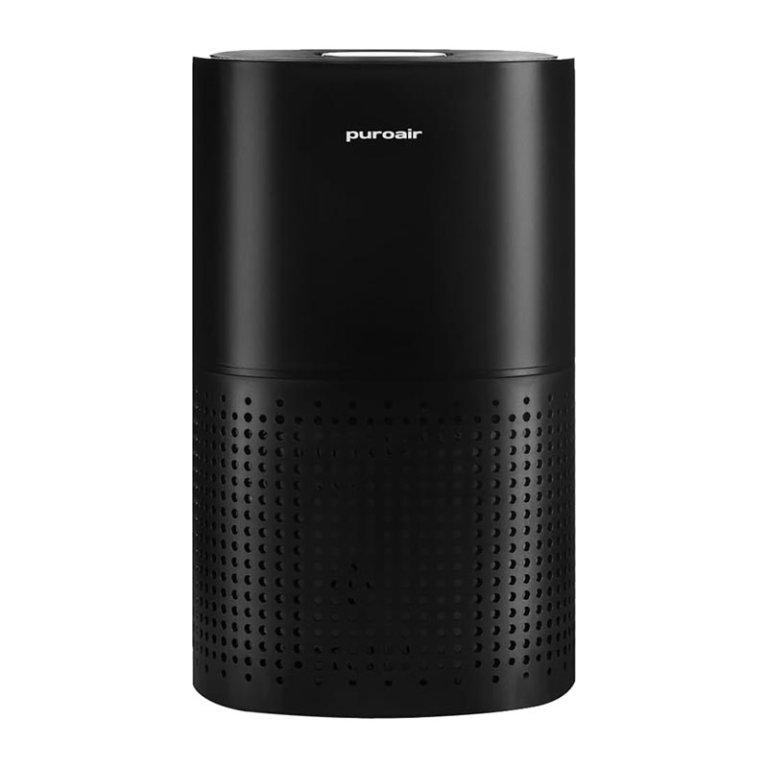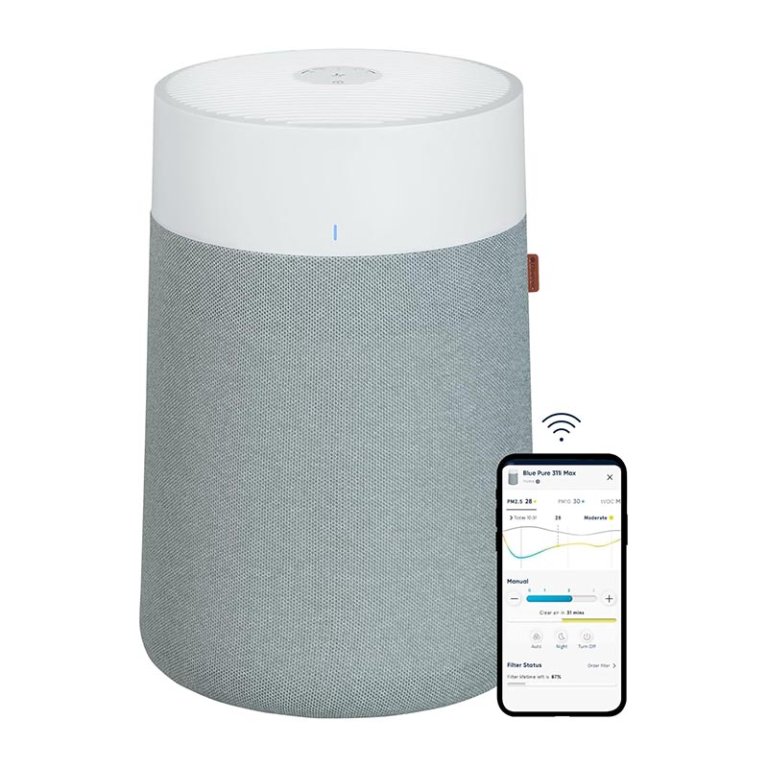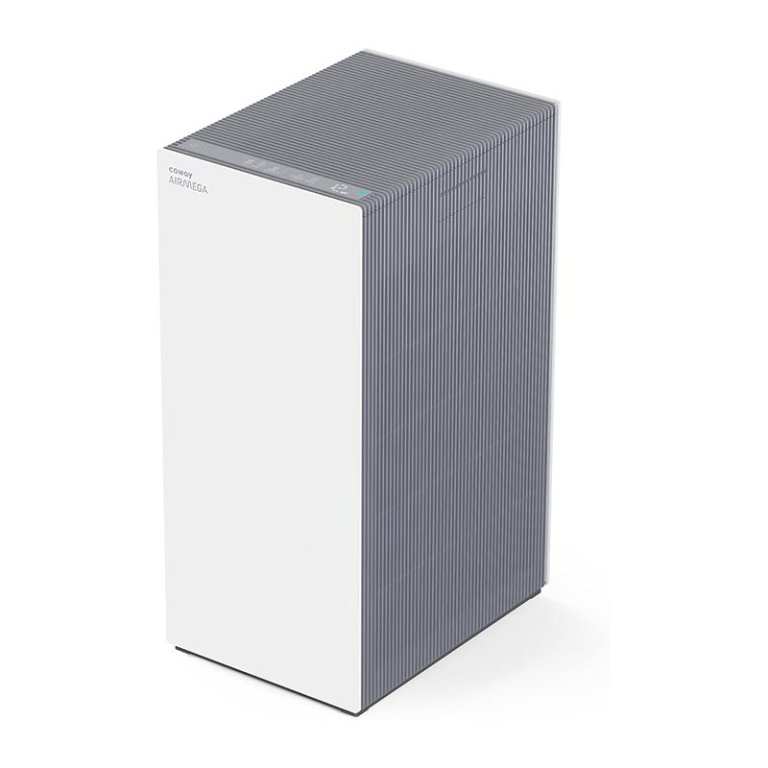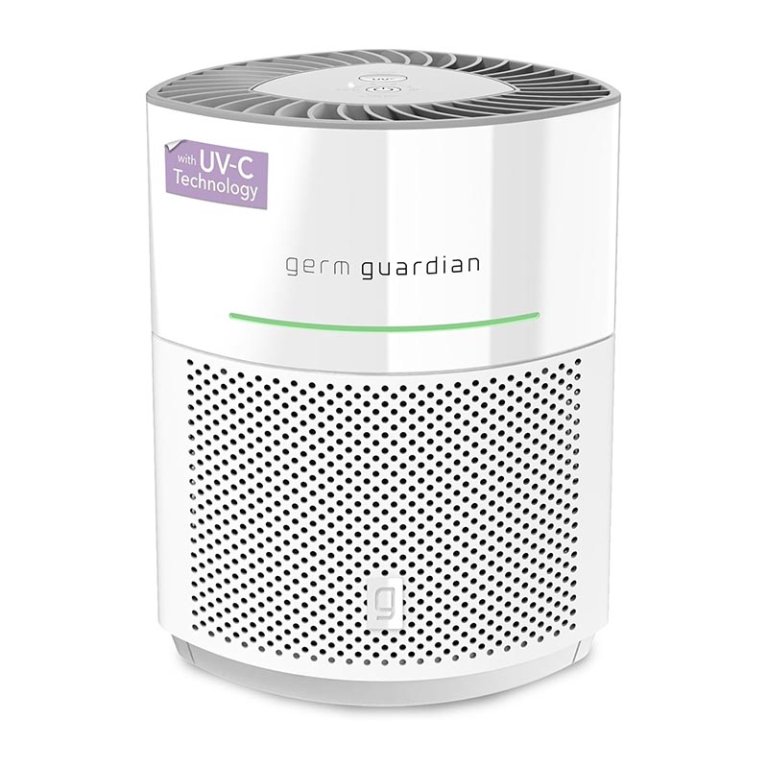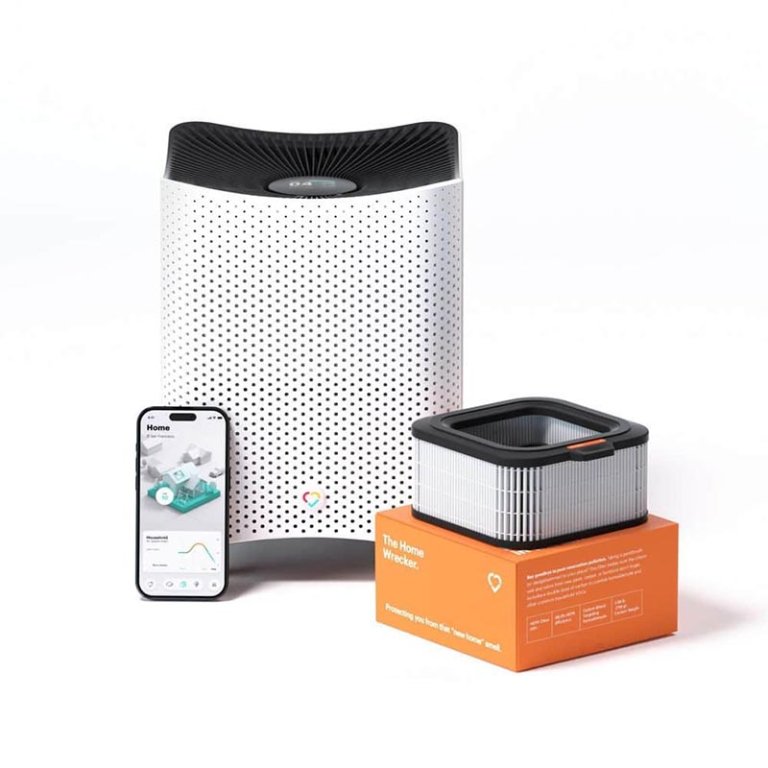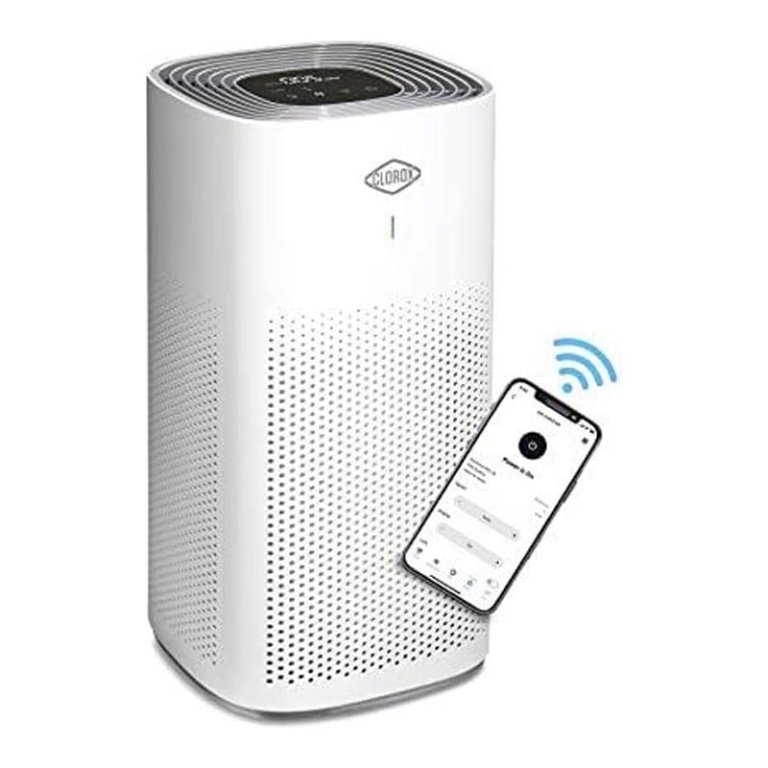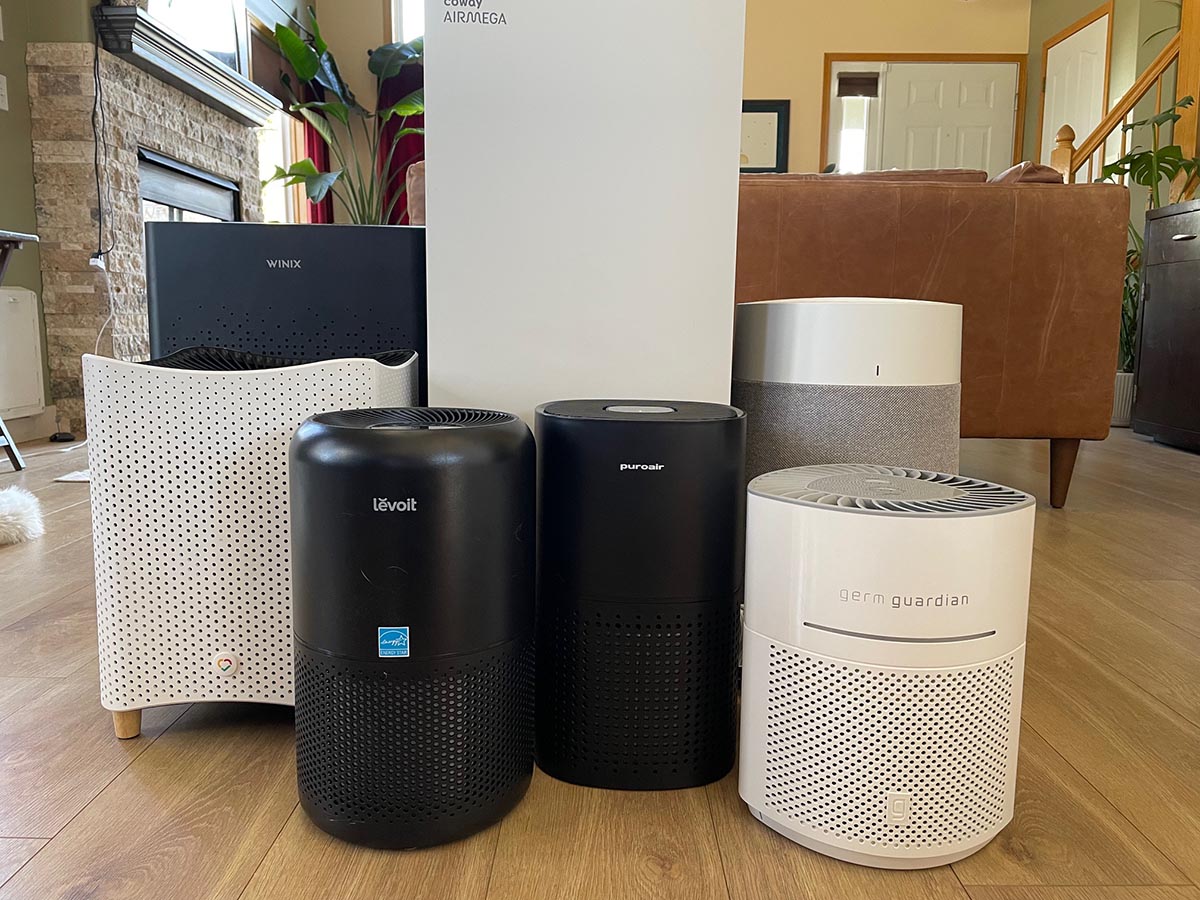
We may earn revenue from the products available on this page and participate in affiliate programs. Learn More ›
Being exposed to unwanted smoke can be as unsafe as it is unpleasant, so to help protect you and your family, we tested 10 popular air purifiers for smoke to find the best options for rooms of all sizes. As a key piece of home technology, a quality air purifier can filter out fine particles of smoke along with common irritants like dust mites, pollen, mold spores, and other pollutants. However, with prices ranging from as little as $100 to nearly $1,000, choosing an effective yet economical unit can be an overwhelming process.
After getting advice from an industry expert and reviewing the results of our hands-on tests, we chose the Coway Airmega AP-1512HH Mighty Air Purifier as our favorite air purifier to remove smoke. Designed for rooms up to 1,748 square feet, it delivers powerful filtration through HEPA and activated carbon filters and also has an ionizer for enhanced performance.
While it’s an excellent choice for many, those with smaller or larger spaces or additional air quality concerns might find that another model is a better fit. With the help of the following reviews on the best air purifiers for smoke, you can more easily find one that’s right for your needs.
- BEST OVERALL: Coway Airmega AP-1512HH Mighty Air Purifier
↓ Jump to Review - BEST BANG FOR THE BUCK: Levoit Core 300 Air Purifier
↓ Jump to Review - BEST FOR SMALL ROOMS: Molekule Air Mini+ Air Purifier
↓ Jump to Review - BEST FOR MEDIUM ROOMS: PuroAir 240 HEPA Air Purifier
↓ Jump to Review - BEST FOR LARGE ROOMS: Blueair Blue Pure 311i Max Air Purifier
↓ Jump to Review - BEST WHOLE HOME: Coway Airmega Pro X Whole Home Air Purifier
↓ Jump to Review - BEST FOR SANITIZING: GermGuardian AC3000 AireSafe Intelligent Air Purifier
↓ Jump to Review - BEST WASHABLE FILTER: Winix AM80 4-Stage True HEPA Air Purifier
↓ Jump to Review - BEST CUSTOMIZABLE: Mila Air 3 Air Purifier With Home Wrecker Filter
↓ Jump to Review - BEST ALEXA-COMPATIBLE: Clorox Alexa Smart Medium Room True HEPA Air Purifier
↓ Jump to Review
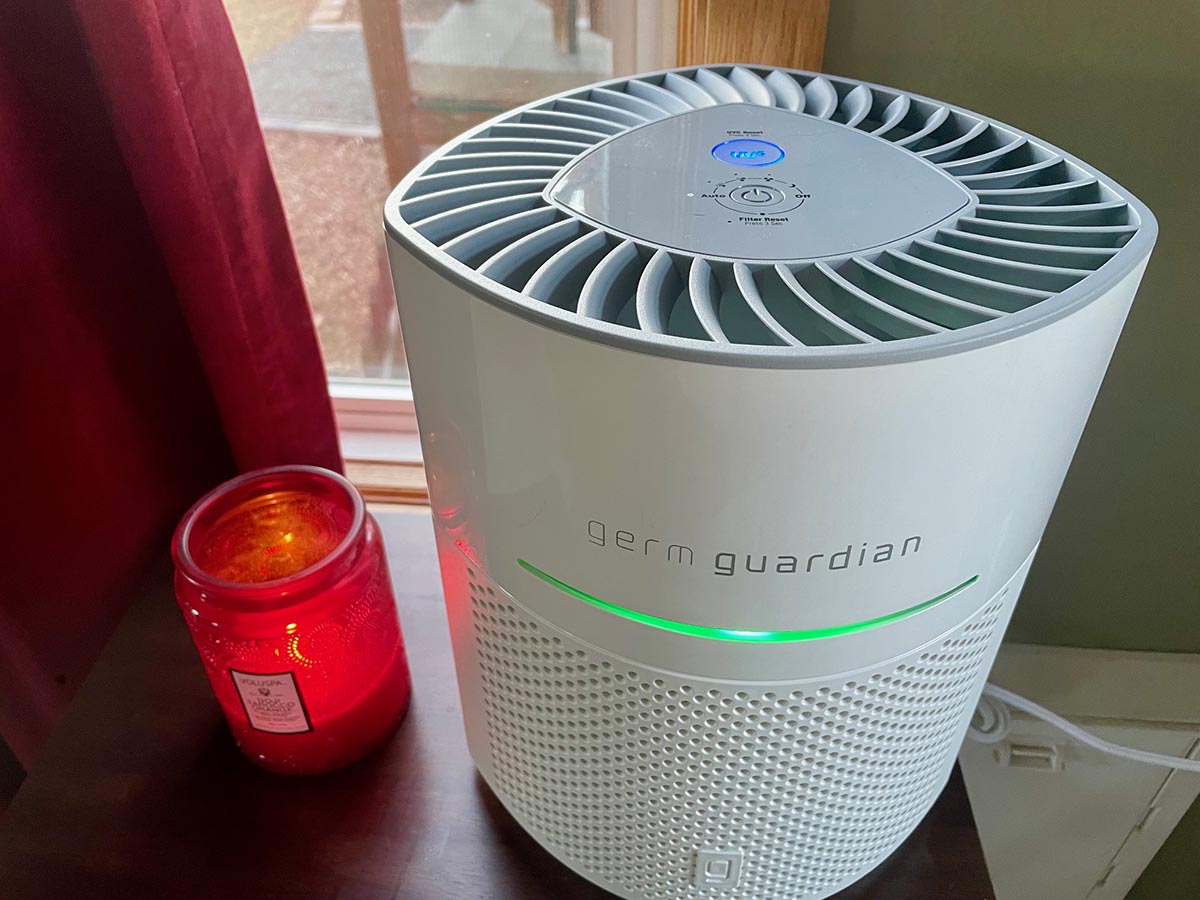
Air Purifiers for Smoke Comparison Chart
| Product Name | Type | Room Size Compatibility | Noise Level |
| Coway Airmega AP-1512HH Mighty Air Purifier | HEPA, activated carbon, and ionizer | Up to 1,748 square feet | 24 to 53 decibels |
| Levoit Core 300 Air Purifier | Three-stage filter with activated carbon | Up to 219 square feet | 24 to 50 decibels |
| Molekule Air Mini+ Air Purifier | HEPA and activated carbon | Up to 250 square feet | 39 to 62 decibels |
| PuroAir 240 HEPA Air Purifier | HEPA and activated carbon | Up to 1,000 square feet | 22 to 48 decibels |
| Blueair Blue Pure 311i Max Air Purifier | HEPASilent and activated carbon | Up to 1,800 square feet | 23 to 50 decibels |
| Coway Airmega Pro X Whole Home Air Purifier | HEPA and activated carbon | Up to 4,253 square feet | 23 to 46 decibels |
| GermGuardian AC3000 AireSafe Intelligent Air Purifier | HEPA, activated carbon, and UV-C | Up to 1,040 square feet | 24 to 55 decibels |
| Winix AM80 4-Stage True HEPA Air Purifier | HEPA and activated carbon | Up to 1,740 square feet | 27 to 51 decibels |
| Mila Air 3 Air Purifier With Home Wrecker Filter | HEPA and activated carbon | Up to 1,000 square feet | 24 to 51 decibels |
| Clorox Alexa Smart Medium Room True HEPA Air Purifier | HEPA and activated carbon | Up to 1,000 square feet | 30 to 48 decibels |
Our Top Picks
Based on our tests, the following models are among the best air purifiers for smoke. To further protect your family, check out our list of the best wildfire smoke essentials for additional fire preparation and response products.
Best Overall
Coway Airmega AP-1512HH Mighty Air Purifier
What We Like
- 4 layers of filtration
- 5 airflow settings, including Auto and Eco modes
- Indicator light shows air quality at a glance
What We Don’t Like
- Boxy design can be difficult to place in a room
- No Wi-Fi connectivity or remote control
Specs
- Type: HEPA, activated carbon, and ionizer
- Room size compatibility: Up to 1,748 square feet
- Noise level: 24 to 53 decibels
Our Ratings: Ease of Use 4.5/5; Performance 4.8/5; Noise 4/5; Value 4.5/5
The Coway Airmega is a powerful air purifier with a four-layer filtration system that can handle everything from smoke and gasses to pet allergens and odors. The prefilter acts as a goalie against the largest particles, the deodorization filter removes smells from the air, the True HEPA filter eliminates tiny particulates, and the bipolar ionizer targets the ultrafine particles the other filters can’t capture. It’s also designed with an at-a-glance air quality indicator light that turns blue for “good,” purple for “moderate,” or red for “unhealthy.”
Though the Coway Airmega doesn’t offer fancy bells and whistles like a remote control or Wi-Fi connection (though that is available on the AP-1512HHS), it’s straightforward to control and does an exceptionally good job of keeping the air clean. In fact, we liked absolutely everything about it other than its slightly bulky square design. Unlike cylindrical or tower-style purifiers, this one doesn’t fit particularly well in a corner, making it a little difficult to place in a room. Still, the overall look is streamlined and modern, and its excellent efficiency at removing smoke during testing made up for us not quite knowing where to position it.
What our tester says: “Our favorite thing about this Coway’s might be its smart Auto mode. Any time we cook, even if the food doesn’t produce much smoke, it increases its fan speed to remove particles that are otherwise undetectable to the naked eye.”—Lizzy Briskin, Product Reviews tester and writer
Get the Coway AP-1512HH air purifier for smoke at Amazon, Walmart, or Coway.
Best Bang for the Buck
Levoit Core 300 Air Purifier
What We Like
- As quiet as 24 dB on the lowest setting for bedroom use
- Energy Star certified for efficient electricity use
- Compatible with the brand’s pet allergy and toxin absorber filters
- Filter replacement indicator helps ensure timely filter changes
What We Don’t Like
- No remote control or app compatibility
Specs
- Type: Three-stage filter with activated carbon
- Room size compatibility: Up to 219 square feet
- Noise level: 24 to 50 decibels
Our Ratings: Ease of Use 4.5/5; Performance 4.1/5; Noise 4.5/5; Value 4.3/5
Levoit is a trusted brand name in the world of air purification filters, and its Core 300 model lives up to the brand’s reputation. This compact, sleek-looking cylindrical purifier blends into any room and has a straightforward touch-screen interface to toggle between the three air speeds, nighttime mode, and the built-in timer. It can run continuously or automatically shut off after 2, 4, 6, or 8 hours. Its lock mode prevents accidental changes to settings, making this purifier a safer option to keep in children’s rooms.
During testing, the Levoit removed dust and smoke from the air after an hour. Though it doesn’t have an automatic mode that increases the fan speed in response to increased particulate matter, it’s easy enough to bump up the speed manually if you experience smoke or an increase in particulate matter in the air.
Besides its air-cleaning capabilities, we were particularly impressed with how quietly this model operates. Our tester kept the Levoit Core 300 purifier in her bedroom for months; even as a light sleeper, she experienced no disturbances with the purifier in nighttime mode. It gets as quiet as 24 dB, which is about the noise level of someone breathing from a distance of about 3 feet away.
Get the Levoit air purifier for smoke at Amazon, The Home Depot, or Levoit.
Best for Small Rooms
Molekule Air Mini+ Air Purifier
What We Like
- Removes mold and viruses from the air
- Modern design suits many aesthetics
- App enables remote control and monitoring
What We Don’t Like
- A bit pricey for a small unit
- Replacement filters are $100 without a subscription
Specs
- Type: HEPA and activated carbon
- Room size compatibility: Up to 250 square feet
- Noise level: 39 to 62 decibels
Our Ratings: Ease of Use 5/5; Performance 3.8/5; Noise 3.8/5; Value 4/5
The Molekule Air Mini+ portable air purifier has an attractive minimalist design that includes a handle, making it easy to place it anywhere it’s needed. It uses three layers of filtration: a True HEPA filter that captures 99.97 percent of particles, an odor- and gas-absorbing carbon layer, and patented PECO (photoelectrochemical oxidation) technology, which helps eliminate viruses and bacteria as small as 0.3 microns. The AirMini+ is also certified by the California Air Resources Board (CARB).
The Mini+ effectively removed smoke and particles from a vacuum bag during our tests. When cooking over high heat produced a lot of smoke in an apartment, the Mini+ cleared the air in under 15 minutes. We also found that it’s relatively quiet at 39 dB on its slowest setting, and we love that we can control it via the app, which also tracks and stores indoor air quality numbers.
The main downside to this otherwise effective air purifier is the price, costing over $100 more than most of our other favorite models. Still, for patented technology, remote control, and air quality monitoring, all in a portable, good-looking package, the Molekule may be worth the high price tag.
Get the Molekule air purifier for smoke at Amazon or Molekule.
Best for Medium Rooms
PuroAir 240 HEPA Air Purifier
What We Like
- Covers quite a large area for its compact size
- Convenient filter change indicator light
- One of the quietest units we tested
What We Don’t Like
- More effective for general pollution than smoke specifically
- Works slower than similar units
Specs
- Type: HEPA and activated carbon
- Room size compatibility: Up to 1,000 square feet
- Noise level: 22 to 48 decibels
Our Ratings: Ease of Use 4.5/5; Performance 4/5; Noise 4.5/5; Value 4.7/5
The PuroAir 240 is a compact air purifier that offers surprising performance for its size. Like many of the models we tested, it uses a three-stage filtration system—a prefilter, HEPA filter, and activated carbon filter—to capture 99.9 percent of pollutants. Though it doesn’t have any advanced features, we found its top panel operation simple and convenient, especially its filter change light so we don’t have to track the replacement timeline on our own.
Performance-wise, the PuroAir did a good job in both our smoke and vacuum canister tests, it was just a bit slower than the units that scored higher. Where it really excels, however, is in being unobtrusive. Even when it kicked into high while we sauteed food on the stove, it never got above 48 decibels, making it a fair bit quieter than many other models we tested. For that fact plus the reasonable price of the unit and its replacement filters, the PuroAir provides pretty great value.
Get the PuroAir air purifier for smoke at Amazon, Walmart, or PuroAir.
Best for Large Rooms
Blueair Blue Pure 311i Max Air Purifier
What We Like
- Attractive and innovative design
- Lightweight at just 7.8 pounds
- Whisper-quiet on low
What We Don’t Like
- Top doesn’t always stay on tightly
- Air quality indicator light is quite small
Specs
- Type: HEPA and activated carbon
- Room size compatibility: Up to 1,800 square feet
- Noise level: 23 to 50 decibels
Our Ratings: Ease of Use 4.3/5; Performance 4.6/5; Noise 4/5; Value 4.8/5
The Blueair 311i large room air purifier is powerful enough for spaces up to 1,800 square feet, making it ideal for open-concept living, kitchen, and dining areas. With perhaps the most unique design of the units we tested, the 311i’s prefilter is actually integrated into the aesthetics of the unit. Available in four colors—moss, limestone, sand, and Stockholm fog—the prefilter covers the entire base of the unit, which is a substantially sized cylindrical filter.
The unique construction of this Blueair unit puzzled us at first, as we thought the entire filtration system was missing. Once we paired the purifier with the Blueair app, however, we realized the hollow base was the “missing” system, which is actually quite ingenious. The prefilter is easy to pull off and wash, and the system performed exceptionally well in our smoke and particle tests. Since the only real weight is in the top fan housing, it’s also incredibly light weight and easy to move as needed. Just watch that you have the top section on tightly before you pick it up, as it will fall off if it’s not clicked into place.
Get the Blueair air purifier for smoke at Amazon, Lowe’s, The Home Depot, Wayfair, Target, Best Buy, or Blueair.
Best Whole Home
Coway Airmega Pro X Whole Home Air Purifier
What We Like
- Wheels and handles make it easy to move
- Quieter than units a fraction its size
- Provides whole-house filtration without HVAC installation
What We Don’t Like
- Might be too big for residential use
- Controls are manual only
Specs
- Type: HEPA and activated carbon
- Room size compatibility: Up to 4,253 square feet
- Noise level: 23 to 46 decibels
Our Ratings: Ease of Use 4.5/5; Performance 5/5; Noise 5/5; Value 4.3/5
The Pro X whole home air purifier comes from Coway, the makers of our top pick. This air purifier for home use performed best in all our tests, as should be expected for a unit compatible with spaces up to 4,253 square feet. The thing we didn’t expect, however, was that it was also the quietest, and its max of 46 decibels was less overbearing than the max of much smaller units. It also works so efficiently that it never had to kick into high gear unless we actively created smoke around it.
With two hidden handles and four built-in wheels, we had no problem moving this 51-pound machine from one room to another. We slept next to it at night and tested it against cooking, incense- and candle-burning, dander and hair from three pets, and a vacuum canister full of dirt and dust. No matter what we threw it at, the Pro X handled it like a, well, pro. We’re guessing that’s because this massive unit has two sets of equally massive washable prefilters, HEPA filters, and activated carbon filters—one on each end. If you have the need and the space for this unit, it comes at a pretty remarkable price. The only thing it doesn’t have are any smart features for remote operation.
Get the Coway Pro X air purifier for smoke at Amazon, The Home Depot, or Coway.
Best for Sanitizing
GermGuardian AC3000 AireSafe Intelligent Air Purifier
What We Like
- Adds UV-C sanitation to HEPA and carbon filtration
- Small yet covers a large area
- Makes almost no sound on low
What We Don’t Like
- Filter removal process isn’t intuitive
- Not the best choice for incredibly smokey spaces
Specs
- Type: HEPA, activated carbon, and UV-C
- Room size compatibility: Up to 1,040 square feet
- Noise level: 24 to 55 decibels
Our Ratings: Ease of Use 4/5; Performance 4.1/5; Noise 4/5; Value 5/5
Looks are deceiving with this small air purifier from GermGuardian, which measures just a foot tall and weighs only 7.02 pounds yet can clean the air in spaces as large as 1,040 square feet. It features a four-layer filtration system, including a 360-degree True HEPA filter that captures 99.97 percent of particles as small as 0.3 microns, a carbon filter for odor reduction, and an optional UV-C light for tackling germs and viruses.
As much as we love auto mode on air purifiers, we noticed that the auto mode on the GermGuardian AC3000 was even more effective than most, as the unit measures air quality an impressive 60 times per minute and adjusts accordingly. Still, this small unit was a bit slower at removing smoke than other options we tested.
We did really like its ultra-quiet mode, however, which was exactly as advertised at just 24 decibels. We also love that the UV-C functionality helps reduce airborne germs like Staphylococcus Albus, Escherichia Coli, Aspergillus Niger, and Phi-X174 as well as airborne bacteria and mold spores, making it particularly well suited to sanitizing sleeping spaces like bedrooms and nurseries.
Get the GermGuardian air purifier for smoke at Amazon, Walmart, or Guardian Technologies.
Best Washable Filter
Winix AM80 4-Stage True HEPA Air Purifier
What We Like
- Automatically enters sleep mode at night
- Front cover is magnetic for easy filter replacement
- PlasmaWave technology helps reduce airborne particles and allergens
What We Don’t Like
- No smart features
- Replacement filters on the expensive side
Specs
- Type: HEPA and activated carbon
- Room size compatibility: Up to 1,740 square feet
- Noise level: 27 to 51 decibels
Our Ratings: Ease of Use 4.8/5; Performance 4.5/5; Noise 4/5; Value 4.3/5
The Winix air purifier with washable filter actually has both a washable prefilter as well as a washable activated charcoal filter. Each is easy to access just behind the magnetic front panel, which pops off and back on effortlessly. In fact, just about every aspect of the Winix AM80 is effortless. Operation is straightforward using the top control panel. It has a real-time air quality indicator for at-a-glance monitoring, and the unit puts itself into sleep mode automatically based on ambient light conditions.
Smoke and particle removal was also excellent with the Winix, meaning there really isn’t much to complain about. If we had to find something, though, it’s that it can be loud on high and replacement filters are on the expensive side. It also doesn’t have any smart features, which we don’t mind, but if you’d like to control your purifier with an app, this isn’t the option for you. Still, if you’re looking for solid, set-it-and-forget-it performance, the Winix AM80 is an excellent choice.
Get the Winix air purifier for smoke at Amazon, Lowe’s, Wayfair, Target, Best Buy, or Winix.
Best Customizable
Mila Air 3 Air Purifier With Home Wrecker Filter
What We Like
- Attractive retro design with cute wooden feet
- Comes with 1 of 7 interchangeable filters
- App provides lots of useful information
What We Don’t Like
- Cover can be tricky to replace after changing filter
Specs
- Type: HEPA and activated carbon
- Room size compatibility: Up to 1,000 square feet
- Noise level: 24 to 51 decibels
Our Ratings: Ease of Use 4.8/5; Performance 4.4/5; Noise 4/5; Value 4.3/5
In all the tests we do, there’s always one product we just aren’t sure about at first, and in these tests, it was the Mila Air 3. From the moment we opened the box, it was noticeably cuter, quirkier, and more elevated than most of the other air purifiers. As soon as we plugged it in, the screen on top came to life with a calibration test, and it gave us an enthusiastic all clear once complete. But our cynical sides quickly rose to the surface, and we found ourselves wondering if there would be substance under the Mila’s adorable aesthetics and effective marketing.
Our tests put our concerns at bay, as performance in both smoke and particulate tests was among the best, and we found it incredibly easy to use once we got familiar with it. Though it claims to be 16 percent quieter than other air purifiers, we found its noise output pretty standard. What we did find special, however, was the minute-by-minute monitoring on the digital screen and the user-friendly functionality of the app. We also really like that you can choose from seven custom filters, including the Home Wrecker for enhanced chemical and odor removal to protect you from that “new home” smell.
What our tester says: “If an air purifier can be fun to use, this one is. It’s cute design always makes me smile, and the app is actually helpful. In addition to real-time air quality monitoring for pollutants and VOCs, it displays carbon dioxide and carbon monoxide levels, temperature and humidity, and even information on outdoor air quality. Plus, you can choose between seven interchangeable filters and eight operational settings, meaning it’s relatively easy to customize the Mila Air 3 to fit virtually any need.”—Michelle Larson, Product Reviews tester and writer
Get the Mila air purifier for smoke at The Home Depot or Mila.
Best Alexa-Compatible
Clorox Alexa Smart Medium Room True HEPA Air Purifier
What We Like
- Color-changing air quality status light on front
- Automatic mode responds e to current air conditions
- Energy star certified
What We Don’t Like
- Not compatible with Google Assistant
- Fan is noisy on high
Specs
- Type: HEPA and activated carbon
- Room size compatibility: Up to 1,000 square feet
- Noise level: 30 to 48 decibels
Our Ratings: Ease of Use 5/5; Performance 4/5; Noise 4.5/5; Value 4.3/5
This Clorox air purifier is a great choice for homes integrated with the Alexa/Amazon ecosystem, allowing remote control and voice control through the Alexa app. Its True HEPA filter captures 99.97 percent of allergens as small as 0.1 microns and 99.9 percent of bacteria and viruses, making it a powerful tool for improving indoor air quality.
One of the things we liked best about this model is its real-time monitoring with color-changing indicator light—green for healthy air quality and red for unhealthy conditions. When set to auto mode, the purifier instantly adjusts fan speed in response to changes. Like many of the products on our list, this Clorox purifier has three layers of filtration: a prefilter for large particles and pet hair; a True HEPA filter for allergens, particulates, bacteria, and viruses; and an interior active-carbon filter for odors, and gases, and volatile organic compounds (VOCs).
What our tester says: “After months of constant use in our New York City apartment, this has been a reliable way for us to eliminate smoke and other visible particles. We love how little space it takes up and how easy it is to control from anywhere.”—Lizzy Briskin, Product Reviews tester and writer
Get the Clorox air purifier for smoke at Amazon, Lowe’s, The Home Depot, Wayfair, or Clorox.
Jump to Our Top Picks
How We Tested the Best Air Purifiers for Smoke
| Testing Stats | |
|---|---|
| Products tested | 10 |
| Time spent testing | Over 6 months |
| Tests performed | 6 |
| Price range | $100 to $850 |
To select models for testing, we researched dozens of options from the most respected brands, combing through hundreds of customer reviews to narrow down our choices. We also followed Frontdoor HVAC expert Ryan McNabb’s advice: “The best filter to remove smoke is, in fact, a combination of filters: a HEPA filter, which removes smoke particles, paired with an activated carbon filter, which removes odor particles.”
In addition to removing smoke and eliminating odors, they also combat dust mites and other particulates that impact air quality and may cause difficulty breathing. Using this information, we finalized our selections based on filtration efficiency, area coverage, noise level, and available fan speeds. We also considered nice-to-have features such as portability and remote operation.
To test the devices, we burned incense near the purifiers and quantified their efficiency at removing the smoke from the air. We also emptied the contents of a vacuum cleaner to test the purifiers’ ability to remove visible particulates from the air. Additionally, we’ve lived with the air purifiers in our homes for months to assess noise levels. Once all tests were complete, we used a detailed rubric to assess the air purifiers’ performance.
| Product Name | Ease of Use | Performance | Noise | Value |
| Coway Airmega AP-1512HH Mighty Air Purifier | 4.5 | 4.8 | 4 | 4.5 |
| Levoit Core 300 Air Purifier | 4.5 | 4.1 | 4.5 | 4.3 |
| Molekule Air Mini+ Air Purifier | 5 | 3.8 | 3.8 | 4 |
| PuroAir 240 HEPA Air Purifier | 4.5 | 4 | 4.5 | 4.7 |
| Blueair Blue Pure 311i Max Air Purifier | 4.3 | 4.6 | 4 | 4.8 |
| Coway Airmega Pro X Whole Home Air Purifier | 4.5 | 5 | 5 | 4.3 |
| GermGuardian AC3000 AireSafe Intelligent Air Purifier | 4 | 4.1 | 4 | 5 |
| Winix AM80 4-Stage True HEPA Air Purifier | 4.8 | 4.5 | 4 | 4.3 |
| Mila Air 3 Air Purifier With Home Wrecker Filter | 4.8 | 4.4 | 4 | 4.3 |
| Clorox Alexa Smart Medium Room True HEPA Air Purifier | 5 | 4 | 4.5 | 4.3 |
What to Consider When Choosing an Air Purifier for Smoke
If you’ve never owned an air purifier or you’re facing wildfire season and want to know how to keep smoke out of your home, finding the right model is much easier if you first understand the technical features and air and environmental ratings. Familiarizing yourself with the numerous acronyms makes comparison shopping much simpler.
Filtration
Air purifiers with multiple filters, including a True HEPA filter and an activated carbon filter, to capture the lingering odors, provide superior smoke filtration.
HEPA filters remove larger unwanted particles, while carbon filters target smaller pollutants, including odors and toxic gases. HEPA filters are proven to trap 99.97 percent of particles with a size of 0.3 microns or larger, including pollen, pet dander, dust mite waste, mold spores, and smoke. They last 6 to 12 months and then need to be replaced.
Look for an air filter that uses “True HEPA” or “HEPA” filters. Be aware when shopping, however, that purifiers labeled “HEPA-type” or “HEPA-like” often don’t have a real HEPA filter and may not meet U.S. Department of Energy standards. Many manufacturers do have their filters independently tested to ensure comparable filtration levels.
In addition to HEPA filters, air filtration for smoke also requires two other types of filters:
- Prefilters capture large particles in the air before reaching and clogging the filtration system. While not a must-have, they are highly economical. HEPA air filters are more costly to replace than prefilters, so the inclusion of both saves money in the long run. Maintaining the prefilter involves monthly cleaning plus replacement if it gets damaged.
- Activated carbon air filters capture some of the gaseous molecules in wildfire smoke and reduce the associated smell. Activated carbon filters remove contaminants ranging from unwanted odors to VOCs by absorption and adsorption. The carbon filter chemically attracts the unwanted elements and traps them in interior pores (absorption) or on its textured surface (adsorption). Carbon filters need to be replaced every 3 to 6 months per manufacturer recommendations.
McNabb emphasizes the importance of a carbon filter when purchasing an air purifier specifically for smoke. “This type of filter is needed to remove odors found in smoke. While a HEPA filter is great at filtering out smoke particles, it is unable to remove those that cause odor,” he says. “A HEPA filter unit with an additional activated carbon filter is what you need to remove smoke and associated odors.”
The systems listed above act as smoke filters; remove allergens, gases, and toxins from the air; and leave your home odor free. If you happen to also be looking for an air purifier for pets, you’ll notice they tend to use the same types of filtration systems since they are so comprehensively effective.
Room Size
Air purifiers are labeled for specific room sizes, which are described in square feet. To find the size you need, calculate the square footage of a room by multiplying the length times the width. Another consideration to keep in mind when looking at room size coverage for air purifiers is the number of air changes per hour (ACH). This number shows how many times per hour the entire air volume of a room will be filtered. The U.S. Environmental Protection Agency (EPA) recommends an air purifier with an ACH of 4.8.
As you look at product descriptions, you may notice that the rating may be shown for a room size different from the product’s “filters up to X square feet” statement, so be sure to read the fine print. For example, a general product description may indicate that an air purifier can be used for rooms up to 1,000 square feet, but the air purifier may only offer one air change per hour at that room size—much lower than the EPA’s recommendation of 4.8.
Energy Efficiency and CARB Certification
Energy Star is a joint program of the EPA and the Department of Energy. The program aims to help customers, businesses, and industries save money and protect the environment using energy-efficient products and practices.
An Energy Star certification means the unit uses less energy than standard products. Certified energy-efficient appliances usually have lower operating costs and create less air pollution than standard equipment. Look for the blue Energy Star logo to find certified products.
CARB develops programs to fight climate change, and part of that initiative is certification for products like portable indoor air cleaners. To be certified, an air cleaner must pass electrical safety tests and, for electronic cleaners, must not produce ozone greater than 0.050 parts per million (50 ppb).
Electronic air cleaners refer to products that include electric air-cleaning technology, such as ionizers or devices with ultraviolet light components. Mechanical air cleaners, on the other hand, only use physical filtration, and as such, produce no ozone.
Air Quality Indicator
If you live in an area associated with higher levels of air pollution—such as a city or town with industrial factories, power plants, or chemical facilities—awareness of the Air Quality Index (AQI) is especially important. The AQI is a national system managed by the EPA that is used to measure and report air quality based on five major pollutants regulated by the Clean Air Act: particle pollution, ground-level ozone, carbon monoxide, nitrogen dioxide, and sulfur dioxide.
AQI ranges from 0 to 500, with high values indicating greater air pollution levels.
- 0 to 50: Good air quality conditions.
- 100 to 150: Air is a moderate health concern for sensitive groups, including people with lung or heart disease, older adults, and children.
- 151 to 299: Air is considered unhealthy for everyone, with the risks of adverse health effects increasing until conditions are deemed hazardous between 300 and 500.
To take the guesswork out of how to test air quality at home, some air purifiers feature an air quality indicator, which typically uses an infrared beam and sensor to detect particulate matter. Some smart air purifiers are capable of automatically adjusting fan speed in response to higher or lower detected air quality levels.
Noise Level
Noise level can be an important consideration, depending on where you plan to place your air purifier.
- Many large air purifiers operate at about 60 dB, the same noise level as a normal conversation.
- Quieter air purifiers operate at a noise level of 40 to 55 dB, making them a better alternative for bedrooms, living rooms, and home offices.
- Models with a noise level as low as 20 to 30 dB are often made for bathrooms, small bedrooms, or even traveling as they emit very little sound (as much as a muffled hum). Several models listed above have a nighttime mode specifically designed for minimum noise.
Portability
When in a new environment, air purifiers can help you sleep better and reduce exposure to airborne pollutants. As such, some air purifiers are designed for travel, with handles, wireless charging, and caster wheels for added mobility. You may even be able to find a plug-in air purifier that’s small enough to carry in a bag or suitcase.
If you need an air purifier for travel, you may want to look for a purifier that boasts a minimum clean air delivery rate (CADR) of 217—representing efficiency and airflow—suitable for an average hotel room size of about 325 square feet.
Additional Features
Different comfort and convenience features can make a good air purifier even better. (Some air purifiers even feature a wireless charger for phones.) Popular features include smart technology, remote controls, operating modes, and easy access for filter maintenance.
- Smart technology: Onboard air quality sensors can automatically adjust the output of the unit in response to the air quality in a home. Bluetooth connectivity, smart-device apps, and compatibility with personal digital assistants allow you to monitor air quality conditions and control the unit while away from home.
- Remote control: Some air purifiers come with a remote control, allowing you to operate the device without accessing the control panel. With smart air purifiers, an app functions as the remote control, allowing you to adjust the device from virtually anywhere. Others are compatible with Alexa and Google Assistant for voice control.
- Programs/settings: All of our favorite air purifiers offer variable fan speed settings, allowing you to increase or decrease filtration power in response to changing conditions, such as when there’s a fire in the fireplace. Some include sleep mode, which runs the purifier at a lower, quieter setting, with or without a built-in night-light. With some smart indoor air purifiers, these operating settings can be programmed to run at specific intervals.
- Filter replacements: Air filters need to be changed periodically, so it helps to have indicator lights that remind you when it’s time for a change. Filter replacement tends to be easier when filter covers and access points are located near the top or front of the machine and are fastened with magnets or sliding latches instead of screws.
A Note on CADR Ratings
In addition to the above callouts and features, air purifiers are also labeled with a CADR. This value is influenced by filter efficiency and airflow in cubic feet per minute (CFM). The higher the CADR rating, the faster the unit can deliver clean air. CADR values can reach a maximum of 450 for smoke and pollen, while 400 is the highest score for dust.
While CADR is a standard for air purifier performance in the U.S., the values can be misleading for purifiers that contain filters other than standard HEPA filtration. Some manufacturers design air purifiers to circulate a lot of purified air at a faster rate, filtering only the larger contaminants. The CADR test does not take into account gases, odors, or VOCs, which are targeted by carbon filters.
FAQs
You might still have some questions about the best air purifiers for smoke to meet your needs. Check out the most commonly asked questions below and find the info you need.
A typical air purifier filtration system includes a True HEPA filter for larger particles, including dust mites, pollen, pet dander, and other allergens. Some include an activated carbon filter for VOCs, gases, and odors. Additionally, certain air purifiers also include a fabric prefilter to trap larger particles before they reach and potentially clog the other air filters.
How well an air purifier works is dependent on the type of smoke, which relates to particle size. The best air purifiers for wildfire smoke effectively reduce particle concentration of visible smoke. For example, they remove wildfire smoke by up to 85 percent, according to the EPA. They further absorb and remove the smell of smoke from the air using an activated carbon filter.
Yes, though only some types of smoke. The combination of a HEPA air purifier with an activated carbon filter is the best solution for smoke. Some kinds of smoke contain particles that pass through a HEPA filter. Smoke particles can be as small as 0.001 microns, while True HEPA filters trap 99.97 percent of particles between 0.3 and 10 microns. HEPA filtration traps visible and particulate matter, such as smoke from wildfires, cigarettes, and burning food.
An air purifier for smoke odor needs to have a True HEPA filter and activated carbon filter to remove the smell of smoke from the air.
Yes, an air purifier to remove smoke is worth it for a smoker, as it can help relieve respiratory symptoms like coughing and wheezing that are caused by inhaling smoke.
The air purifiers for smoke we tested in this guide cost between $100 and $850, which is representative of the typical price range for these units.
According to Frontdoor HVAC expert, Ryan McNabb, “Placing the air purifier close to the source of smoke is more efficient in removing smoke particles. Placing the air purifier in the same room and within close vicinity to the source of smoke will allow the air to circulate through the purifier with ease.”
Meet the Tester
Michelle Larson has been a writer and editor for more than 10 years in the fields of health, business, and the home. Because she’d rather spend a little more up front than buy a tool or appliance twice, she strongly believes in the power of research and reviews for finding quality items that are meant to last.
Lizzy Briskin is a writer and chef based in New York City. She has been testing and reviewing home products and appliances for over 7 years and has worked as an editor at Real Simple, Food Network, and Pioneer Woman Magazines. She contributes to Wirecutter, The Kitchn, Apartment Therapy, and Simply Recipes.
Additional research provided by Mark Wolfe.
